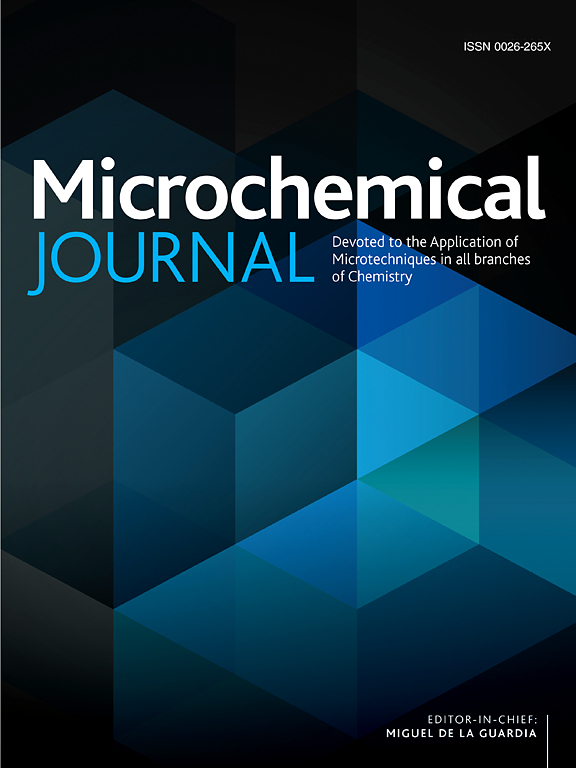利用天然多酚化合物桑辣素的螯合和螯合能力在丝网印刷碳电极(SPCEs)上对Ni2+的电化学传感
IF 4.9
2区 化学
Q1 CHEMISTRY, ANALYTICAL
引用次数: 0
摘要
该研究旨在开发一种在水溶液中选择性检测Ni2+的替代策略,探索天然多酚配体morin (MRN, L5−)的螯合和隔离特性。为此,测定了Ni2+-MRN物质(NaCl水溶液中,I/mol L−1 = 0.15,T/K = 298.15)的形成常数,评价了不同pH条件(2.0≤pH≤9.0)下MRN对Ni2+的固相能力。在此pH范围内,循环伏安法(CV)实验在MRN上进行,不含Ni2+和存在Ni2+。在这两种情况下,MRN的峰值阳极电流(ipa)在pH 7.3时更高。因此,利用该配体的结合能力,利用不同脉冲伏安法(DPV)对briton - robinson (pH 7.3)缓冲液中含有Ni2+的MRN溶液进行滴定,以电化学检测Ni2+。线性浓度范围为:0.5≤[Ni2+]/nmol L−1≤9.3,检出限(LOD)为0.21 nmol L−1,定量限(LOQ)为0.71 nmol L−1。定义了Ni2+-MRN体系的稳定性、可重复性、再现性和选择性。对Ca2+、Mg2+、Mn2+、Fe2+、Co2+、Cu2+、Zn2+的选择性进行了100倍浓度的研究。本文章由计算机程序翻译,如有差异,请以英文原文为准。
Electrochemical sensing of Ni2+ on Screen-Printed Carbon Electrodes (SPCEs) by exploiting the chelating and sequestering abilities of the natural polyphenolic compound morin
The research aimed to develop an alternative strategy for the selective detection of Ni2+ in aqueous solution, exploring the chelating and sequestering properties of a natural polyphenolic ligand, morin (MRN, L5−). To this end, the formation constant values of Ni2+-MRN species (in NaCl aqueous solutions, at I/mol L−1 = 0.15 and T/K = 298.15) were determined to evaluate the sequestering abilities of MRN toward Ni2+ under different pH conditions (2.0 ≤ pH ≤ 9.0). In this pH range, Cyclic Voltammetry (CV) experiments were conducted on MRN, without and in the presence of Ni2+. In both cases, the peak anodic current (ipa) of MRN was higher at pH 7.3. Therefore, the binding ability of the ligand was exploited to electrochemically detect Ni2+ by performing titrations of MRN solutions with Ni2+ in Britton-Robinson (BR) buffer (pH 7.3) using Different Pulse Voltammetry (DPV). The linear concentration range was found to be: 0.5 ≤ [Ni2+]/nmol L−1 ≤ 9.3, with Limit of Detection (LOD) and Limit of Quantification (LOQ) values of 0.21 nmol L−1 and 0.71 nmol L−1, respectively. The stability, repeatability, reproducibility and selectivity of the system Ni2+-MRN were also defined. For the study of selectivity, Ca2+, Mg2+, Mn2+, Fe2+, Co2+, Cu2+ and Zn2+, up to a 100-fold concentration, were taken into account.
求助全文
通过发布文献求助,成功后即可免费获取论文全文。
去求助
来源期刊

Microchemical Journal
化学-分析化学
CiteScore
8.70
自引率
8.30%
发文量
1131
审稿时长
1.9 months
期刊介绍:
The Microchemical Journal is a peer reviewed journal devoted to all aspects and phases of analytical chemistry and chemical analysis. The Microchemical Journal publishes articles which are at the forefront of modern analytical chemistry and cover innovations in the techniques to the finest possible limits. This includes fundamental aspects, instrumentation, new developments, innovative and novel methods and applications including environmental and clinical field.
Traditional classical analytical methods such as spectrophotometry and titrimetry as well as established instrumentation methods such as flame and graphite furnace atomic absorption spectrometry, gas chromatography, and modified glassy or carbon electrode electrochemical methods will be considered, provided they show significant improvements and novelty compared to the established methods.
 求助内容:
求助内容: 应助结果提醒方式:
应助结果提醒方式:


